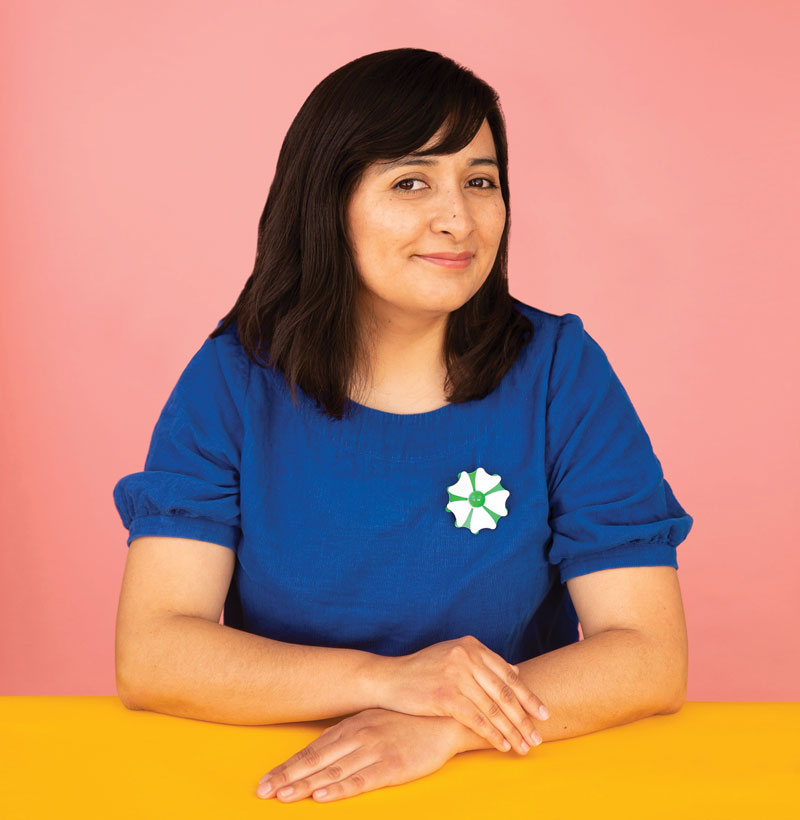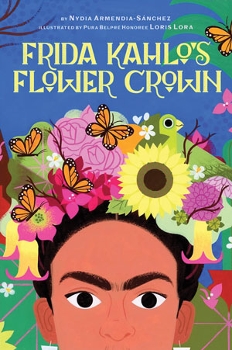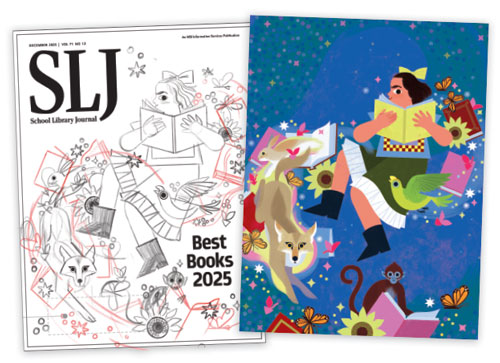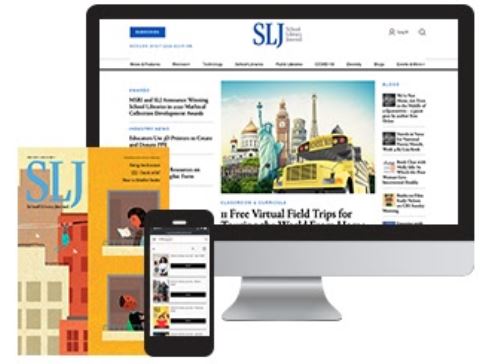Interview with Phenomenal Best Books Cover Artist Loris Lora
SLJ chats with the Pura Belpre–winning artist about the creative process for this year’s December Best Books cover.
★ 2025 BEST BOOKS COVER ILLUSTRATOR ★
 |
Photo by Jessica Watkins |
 Since 1997, School Library Journal’s December issue cover has been created by an artist whose work was chosen as an SLJ Best Book that same year. Past illustrators include Maurice Sendak, Bryan Collier, and Yuyi Morales. This year’s cover was made by two-time Pura Belpré Honor–winning Loris Lora, illustrator of one of SLJ’s 2025 Best Books, Frida Kahlo’s Flower Crown (Abrams), by Nydia Armendia-Sánchez.
Since 1997, School Library Journal’s December issue cover has been created by an artist whose work was chosen as an SLJ Best Book that same year. Past illustrators include Maurice Sendak, Bryan Collier, and Yuyi Morales. This year’s cover was made by two-time Pura Belpré Honor–winning Loris Lora, illustrator of one of SLJ’s 2025 Best Books, Frida Kahlo’s Flower Crown (Abrams), by Nydia Armendia-Sánchez.
Frida Kahlo’s Flower Crown is the second picture book biography Lora has illustrated; the first was Phenomenal AOC: The Roots and Rise of Alexandria Ocasio-Cortez by Anika Aldamuy Denise (HarperCollins, 2022).
In her bordered illustrations for Frida Kahlo’s Flower Crown, arrayed in the colors of a Mexican sunrise, children can play hide-and-seek with the flora of the region: tejocote, prickly pear, date palm, Mexican wild yam, old man cactus, and more. These have the simple sensibility of potato stamps but are far more delicate—an iridescent feast.
Lora shifts easily from biographies of powerful women to board books that will entice children into reading; in Laura Gehl’s Who Laid These Eggs? and Who Dug This Hole? (both Abrams, 2025), the illustrations are full of bulging, bold shapes of friendly creatures that elevate the lift-the-flap concept to fresh new heights.
For May Your Life Be Deliciosa by Michael Genhart (Abrams, 2021), Lora infused the illustrations with the colors of her Mexican heritage, with saturated pastels that head in the direction of neon but never stray from more subdued origins.
Magazines versus books
SLJ asked Lora what’s different about the process of designing magazine covers as compared to book illustration. The difference is designing within the given parameters. For Lora, “this included designing around all the magazine cover text and labels while also trying to captivate the audience’s attention with a single image. It can be quite a task, but I enjoy storytelling and eye-catching images.”
 The prompts for any Best Books cover artist—stars, readers, celebration—are daunting, but Lora plunged in. “Frida surrounded herself with plants, books and curiosities; I found a connection to the prompts through this,” Lora explains.
The prompts for any Best Books cover artist—stars, readers, celebration—are daunting, but Lora plunged in. “Frida surrounded herself with plants, books and curiosities; I found a connection to the prompts through this,” Lora explains.
“The cover was largely inspired by an early spread where young Frida is playing with her imaginary friend (herself, as a nod to her 1939 The Two Fridas) under a cedar tree. I envisioned this version of Frida further escaping into her curiosity and imagination through the books and stories she reads,” Lora reflects. “Brightly colored stars, flowers, and animal creatures emerge from the pages and loop around her in the night sky. I think of how the stories we tell also evoke this same sense of curiosity and imagination.”
Armendia-Sánchez’s text guided Lora’s illustration choices. “Nydia’s writing was always my north star when illustrating the book,” Lora says. “Whenever I felt like I was too overwhelmed on details of Frida’s biography and making sure everything was factually correct, I always referred back to Nydia’s storytelling as the main inspiration and focal point. She beautifully blends Frida’s biography with nature in a very poetic way, and I wanted to match it. My goal as an illustrator is to bring text and image together to create a powerful book for readers to enjoy.”
She had a chance to contribute details beyond the text, without taking the book off course. “Behind Nydia’s words is a heavy amount of research into Frida Kahlo’s complex life,” Lora notes. “Details about the time period, what her garden looked like, and Frida’s lifestyle all support the story in ways that are not mentioned in the text. Incorporating these details and knowing when to pull back was essential. I wanted to make sure it was true to the story Nydia wrote and be able to interpret it in my artistic voice.”
As with her work on Phenomenal AOC, Lora brings bold visuals to tell the story of a strong woman of color via flattened perspectives and impressionistic blocks that are unconventional in a picture book biography.
Naming such influences as Charley Harper, Alice and Martin Provensen, Mary Blair, J.P. Miller, and Alexander Girard, Lora says, “A lot of my influences come from mid-century artists and graphic designers who are shape-based and graphic in their approach.”
She explains further: “Perspective is often implied through basic shapes and can lend itself to storytelling and creating strong compositions. Over the years, I’ve really learned to embrace this way of looking at things and bring it into my practice with modern sensitivities. Color plays an important role in my storytelling and often helps evoke emotions through the harmonies created. My sense of color not only comes from learning color theory but also from my Mexican culture and upbringing.”

Addressing difficult truths
The author and Lora had to grapple with aspects of Kahlo’s story that the artist foreshadows in choices that carry through to Kahlo’s later years.
“Her iconic brow is instantly recognizable and might be one of the first things we notice when we envision Frida,” Lora says. “It was a helpful detail to lean on when depicting young Frida and following her through the years. With any story where we follow a character aging, it’s helpful to have a specific feature or color palette to help the reader follow the character. Even on the magazine cover, her eyes and brows are instantly recognizable under her flower crown.”
Kahlo’s polio and her later, serious streetcar accident are difficult parts to include in a children’s book, but Armendia-Sánchez does; Lora embraced the direct approach with the illustrations as well. “We wanted to not shy away from these very difficult parts of her life, even if we found creative ways in showing it,” Lora continues. “One of the notes I remember discussing with the team was making sure Frida’s right leg was much thinner due to polio. It might not be noticeable at first, but it’s a very important detail.”
“Symbolism can be a helpful tool when illustrating difficult moments,” Lora says. “Instead of showing an actual accident, we showed her in bed recovering and being uplifted by creativity. But if you look closely at the illustration, near the vase with broken stemmed flowers, I drew a skeleton figurine and toy streetcar on the nightstand to help illustrate this tragic moment in her life and how close she was to death.”
“Finally, on the last spread, the team and I felt it was important to show her in a wheelchair painting surrounded by nature. Frida dealt with a lot of chronic pain throughout her life and often painted in bed or in a wheelchair. It’s important to show people throughout history with disabilities who also did remarkable things. Frida’s resilience is incredibly inspiring and an important fact to know about one of the most celebrated Latina artists in history.”
Future projects
Lora has several new works underway, including 123s of Baby’s Needs, a sequel to the ABCs of Baby’s Needs (both little bee books), and a nonfiction title with Nosy Crow.
“I enjoy being able to illustrate various types of books for all ages and collaborating with authors,” she shares. “Recently though, I’ve been trying to tap into writing and illustrating my own picture book projects and looking forward to being inspired.”

RELATED
The job outlook in 2030: Librarians will be in demand
The job outlook in 2030: Librarians will be in demand
ALREADY A SUBSCRIBER? LOG IN
We are currently offering this content for free. Sign up now to activate your personal profile, where you can save articles for future viewing







Add Comment :-
Be the first reader to comment.
Comment Policy:
Comment should not be empty !!!